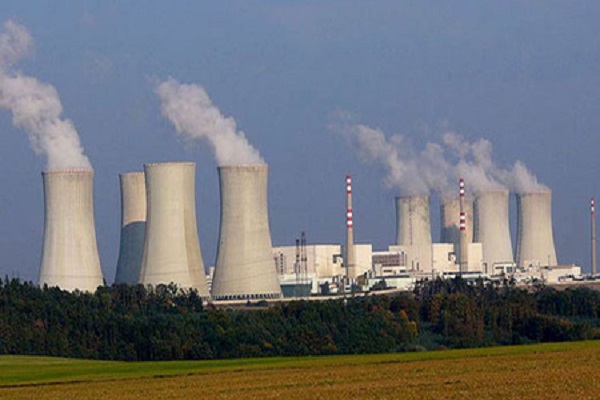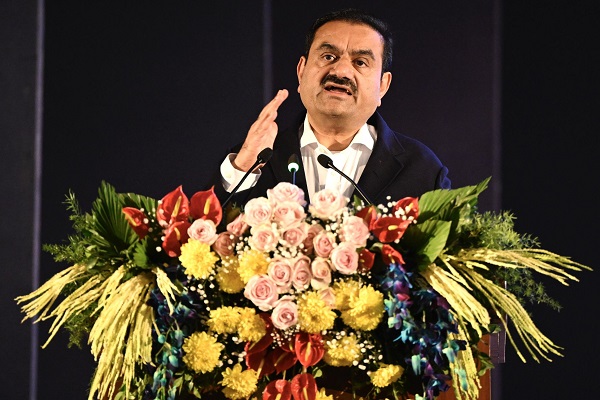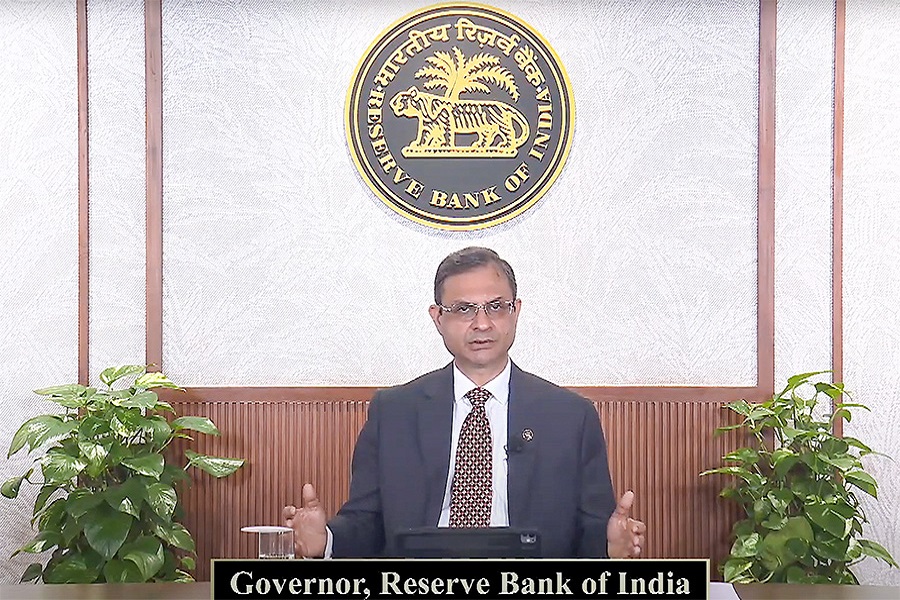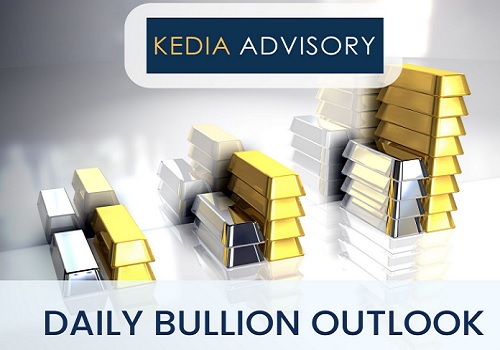Jeera trading range for the day is 23260-25780 - Kedia Advisory

Gold
Gold futures settled down by 1.3% at Rs.86,928, impacted by a wider market sell-off triggered by U.S. President Donald Trump's tariff measures. The sell-off deepened as President Trump’s aggressive stance on tariffs worsened global trade tensions. Federal Reserve Chairman Jerome Powell warned that tariffs could lead to higher inflation and slower growth, adding to the uncertainty. This volatility contributed to a pullback in gold prices, traditionally seen as a safe-haven asset. In response to U.S. tariffs, China retaliated with a series of counter-measures, including additional 34% tariffs on U.S. goods and export curbs on rare earths, further escalating the trade war. Despite this, China’s central bank continued to increase its gold reserves, marking the fifth consecutive month of gold buying in March, bringing their reserves to 73.7 million fine troy ounces. On the physical demand side, gold premiums in China rose due to trade war jitters, while Indian demand remained subdued, with dealers offering discounts of up to $20 per ounce. The World Gold Council anticipates a slight moderation in India’s gold consumption for 2025, forecasting demand between 700-800 metric tons, down from 802.8 tons last year, primarily due to high prices dampening jewelry demand. Technically, the market is witnessing long liquidation, as open interest fell by -10.07% to 14,810 contracts, with prices down by Rs.1,147. Gold is finding support at Rs.86,170, and if breached, could test Rs.85,405. On the upside, resistance is at Rs.88,240, with potential to test ?89,545 if momentum strengthens.
Trading Ideas:
* Gold trading range for the day is 85405-89545.
* Gold prices fall amid tariff-induced market sell-off.
* Fed’s Powell warns of inflation and slower growth risks.
* Gold reserves in London vaults rise 0.1% m/m in March, says LBMA
Silver
Silver prices settled up by 1.19% at Rs.88,248, recovering from a sharp three-day selloff in which the metal had lost nearly 16%, as investors reassessed the broader economic impact of escalating trade tensions sparked by U.S. President Donald Trump’s tariffs. Despite the temporary rebound, the trade war between the U.S. and China continues to cast uncertainty over global markets. China's announcement of 34% tariffs on all U.S. goods starting April 10 has intensified concerns of a slowdown, driving some investors back to safe-haven assets like silver. Interestingly, while other markets remained under pressure, silver gained support from expectations of further Federal Reserve rate cuts, which could provide a bullish outlook for non-yielding assets. Additionally, the 2025 silver market is forecast to remain in deficit for the fifth straight year, with global demand stable at 1.2 billion ounces. This includes record-high industrial fabrication demand projected to exceed 700 Moz, driven by structural gains in the green economy and industrial sectors. Meanwhile, physical investment demand is forecast to grow by 3%, particularly in Europe and North America, as investors adjust to elevated price levels. Technically, silver is in a short covering phase, as open interest dropped by 7.19% to 22,649, while prices gained Rs.1,037. Support is seen at Rs.87,145, with a break lower possibly testing Rs.86,040, while resistance lies at Rs.89,890, with a potential move toward Rs.91,530 if bullish momentum continues.
Trading Ideas:
* Silver trading range for the day is 86040-91530.
* Silver rallied as investors continued to assess the impact of US President’s escalating trade war on the global economy.
* Silver received renewed support as traders pile on bets for further Federal Reserve rate cuts this year.
* EU's Trade Chief Sefcovic: We have offered the US zero for zero tariffs for cars and all industrial goods.
Crude oil
Crude oil prices settled 0.34% lower at Rs.5,293, pressured by growing concerns that the escalating global trade war, particularly China’s retaliation against U.S. tariffs, could dampen global economic activity and, in turn, weaken oil demand. Despite some support from hopes of a Federal Reserve rate cut amid global growth fears, bearish sentiment weighed heavily on prices. Asian crude imports dropped by 640,000 barrels per day (bpd) in Q1 2025 compared to the same period in 2024, falling short of expectations from OPEC and the IEA, who had forecast Asia to lead global oil demand growth. Market pressure was further intensified by a slew of recession warnings from major financial institutions: Goldman Sachs projected a 45% chance of a U.S. recession, while JPMorgan pegged global recession odds at 60%. In response to weakening demand signals, Saudi Arabia slashed its May selling prices for Asian buyers to a four-month low, highlighting softening demand in the region. Additionally, the OPEC+ alliance announced plans to return 411,000 bpd to the market in May, up significantly from the earlier planned 135,000 bpd. Meanwhile, U.S. crude inventories jumped by 6.165 million barrels, defying expectations of a drawdown, with Cushing stocks rising by 2.373 million barrels, further reflecting oversupply. From a technical perspective, the market is under long liquidation, with open interest dropping 3.11% to 17,614 while prices slipped Rs.18. Crude is finding support at Rs.5,082, and a break below could lead to a test of Rs.4,870. Resistance is seen at Rs.5,496, and a move above could push prices toward Rs.5,698.
Trading Ideas:
* Crudeoil trading range for the day is 4870-5698.
* Crude oil dropped on fears global trade war could slow economy
* Fed rate cut hopes support crude amid global growth fears.
* OPEC+ to boost output by 411,000 bpd in May, urges compliance.
Natural gas
Natural gas prices fell by 2.3% to Rs.322.6, pressured by declines in daily LNG exports, forecasts for mild weather, and lower demand expectations over the coming two weeks. Despite lower output so far in April, with average production in the Lower 48 U.S. states dipping to 105.7 bcfd from a record 106.2 bcfd in March, the bearish sentiment was driven by weaker short-term consumption projections. Mild weather in March allowed utilities to inject gas into storage — a rare occurrence for the month — adding 29 billion cubic feet (bcf) during the week ending March 28, exceeding expectations of a 27 bcf build. This marks the third straight week of storage builds, contrasting sharply with a 37 bcf draw in the same week last year and a five-year average draw of 13 bcf. While storage levels remain 3% below normal and 21.7% lower year-on-year, the bearish overtones continue as the EIA projects both supply and demand to hit record highs in 2025. Dry gas production is expected to rise to 104.6 bcfd, while domestic consumption is forecast to edge up to 90.7 bcfd, alongside a jump in LNG exports to 14.0 bcfd. Technically, the market is witnessing fresh selling pressure, reflected by a 13.92% surge in open interest, now at 10,966. With prices down Rs.7.6, support lies at Rs.314.7, and a break below could push prices toward Rs.306.7. On the upside, resistance is seen at Rs.334.7, with further potential up to Rs.346.7 if bullish momentum returns.
Trading Ideas:
* Naturalgas trading range for the day is 306.7-346.7.
* Natural gas dropped on a decline in daily LNG exports and forecasts for mild weather
* US gas output on track to drop from record high in March
* US gas inventories on track for rare build in March
Copper
Copper prices edged up by 0.1% to Rs.805.6, supported by short covering following pressure from escalating global trade tensions. Market anxiety intensified as China retaliated with a 34% tariff on all U.S. goods, deepening fears of a recession. Despite this, copper was excluded from the latest round of U.S. tariffs, offering a degree of relief for traders. In the broader supply landscape, Chile, the world’s top producer, reported $4.45 billion in copper exports for March, a 3.2% year-on-year increase. However, Chile is expected to revise its 2025 copper price forecast down to $3.90–$4.00/lb, from a prior $4.25/lb, amid shifting market expectations. On the production front, Chile’s copper output fell 2.1% year-on-year in January, and Glencore’s force majeure at the Altonorte smelter has added to supply-side uncertainty. Meanwhile, China’s refined copper output grew by 3.7% in January–February, signaling stronger domestic processing capabilities. However, unwrought copper imports into China declined by 7.2%, reflecting lower external demand due to improved domestic smelting. Despite the decline, concentrate imports rose by 1.3%, pointing to robust feedstock demand. From a global balance perspective, the refined copper market posted a 19,000-ton deficit in January, slightly narrowing from December. This tightening supply scenario is offering underlying support to prices. Technically, copper is in a short-covering phase with open interest falling 17.13% to 6,386. Immediate support is at Rs.788, with further downside risk toward Rs.770.4. On the upside, resistance is seen at Rs.824.8, with a breakout potentially extending gains to Rs.844.
Trading Ideas:
* Copper trading range for the day is 770.4-844.
* Copper gains on short covering after pressure seen amid growing fears of escalating trade war.
* China retaliated with a 34% tariff on all US imports, effective April 10, opting not to negotiate.
* Chile exported $4.45 billion of the metal in March, up 3.2% from a year earlier
Zinc
Zinc prices ended marginally higher by 0.16% at Rs.253.2, supported by a decline in inventory levels and renewed short covering. Latest data from the London Metal Exchange (LME) revealed a 1,950-ton (1.5%) drop in zinc stocks, with Singapore warehouses contributing entirely to the decline. On-warrant stocks at the LME also fell sharply to 94,700 tons, the lowest since November 2023, following significant fresh cancellations of 42,575 tons—indicating tightening near-term supply. President Trump’s tariff push, labeled as “economic bullying” by China, has led Citi Research to cut its 2025 zinc price forecast to $2,630/t, reflecting the anticipated slowdown in global demand. On the supply front, China’s zinc production rose 1.8% YoY to 1.13 million metric tons in Jan–Feb, but February alone saw an 8% MoM and over 4% YoY drop due to holidays and regional smelter maintenance. Meanwhile, production cuts from Nyrstar’s Hobart smelter in Australia—reducing capacity by 25%—have supported prices. The Red Dog Mine in Alaska, responsible for 10% of global zinc output, is also expected to slow output in 2025, adding further supply pressure. Looking ahead, China's March zinc production is expected to rebound by 13% MoM, driven by increased working days, post-holiday recoveries, and new capacity. Technically, zinc is in a short-covering phase with open interest down 8.2% to 3,236. Immediate support is at Rs.247.9, below which prices may test Rs.242.5. On the upside, resistance is seen at Rs.257.7, with potential to extend to Rs.262.1 if bullish momentum strengthens.
Trading Ideas:
* Zinc trading range for the day is 242.5-262.1.
* Zinc gains after LME zinc stocks decreased by 1.50% to 128,325 tons
* Citi Research revised down its 2025 base metals price outlook, citing significant headwinds for demand.
* Global zinc market deficit fell to 10,000 metric tons in January from 41,100 tons in December
Aluminium
Aluminium prices rebounded by 0.84% to Rs.234.15, buoyed by bargain buying after recent sharp declines. The recovery came despite continued global market turbulence and lingering trade tensions, as buyers capitalized on the price dip to increase purchases significantly. On the trade front, President Trump reaffirmed a hardline stance, insisting on resolving the U.S. trade deficit before considering a deal with China. In retaliation, China imposed additional tariffs of 34% on all U.S. goods and introduced export controls on certain rare earths, heightening geopolitical risks. Inventory data from the London Metal Exchange (LME) showed a drop in aluminium stocks by 2,050 tons to 454,700 tons, with Port Klang accounting for 2,000 tons of the decline—signaling increased physical demand. Meanwhile, global production pressures persist. While China’s 2024 aluminium output hit a record 44 million tons, output is expected to slow due to Beijing’s 45 million ton production cap, aimed at curbing excess supply and supporting environmental goals. February 2025 production saw a 0.4% YoY rise but dropped month-on-month by 95,000 mt. Although exports of unwrought aluminium and products grew 17% YoY in the first ten months of the year, recent removal of tax rebates has curbed outbound shipments, nudging producers to focus on domestic markets. Technically, the market shows signs of short covering, with open interest down 1.48% to 3,793 as prices gained Rs.1.95. Immediate support lies at Rs.230.4, with a break potentially testing Rs.226.7, while resistance is seen at Rs.237.1, and a move above could take prices toward Rs.240.1.
Trading Ideas:
* Aluminium trading range for the day is 226.7-240.1.
* Aluminium gains as buyers used collapse in prices to significantly increase purchases.
* LME aluminium inventory decreased by 2,050 tons, with the largest drop in Port Klang warehouses
* At the same time, output is increasing, with alumina producers in Guinea, Australia, and China expanding capacity.
Cotton
Cotton prices experienced an uptick, closing at 54,960, following the USDA's recent planting intentions report indicating a 12% reduction in U.S. all-cotton intended planting for 2025, totaling 9.8 million acres. This In India, the Cotton Association of India (CAI) has further reduced its 2024-25 crop estimate by 2% to 295.30 lakh bales, down from earlier projections of 301.75 lakh bales. This downward revision is attributed to lower-than-expected crop yields in central India. The reduction in acreage, with farmers shifting to other crops such as groundnuts, has significantly impacted production levels. Consequently, India's cotton imports are expected to double to 32 lakh bales during the 2024-25 season, up from 15.20 lakh bales last season, to meet domestic demand. The USDA's latest balance sheet for 2024/25 indicates minimal changes for the U.S., with domestic mill use reduced by 100,000 bales and ending stocks raised by the same amount, resulting in an ending stocks-to-use ratio of 39%. The season-average upland farm price projection has been lowered to 63.5 cents per pound. Globally, production and ending stocks have increased, with China's cotton crop rising by one million bales, offsetting declines in other regions. From a technical perspective, the cotton market is experiencing fresh buying, evidenced by a 2.06% increase in open interest, settling at 248 contracts. Prices rose by 520 rupees. Currently, support is observed at 54,660, with a potential test of 54,360 levels if breached. Resistance is anticipated at 55,200, and a move above this level could see prices testing 55,440.
Trading Ideas:
* Cottoncandy trading range for the day is 54360-55440.
* Cotton gained after USDA report showed lower-than-expected U.S. planting estimates.
* USDA's planting intentions report showed U.S. all-cotton intended planting of 9.8 million acres for 2025, a 12% reduction from 2024.
* CAI has further reduced its 2024-25 crop estimate by 2 per cent to 295.30 lakh bales.
* In Rajkot, a major spot market, the price ended at 25621.65 Rupees dropped by -0.1 percent.
Turmeric
Turmeric futures fell sharply by 5.92%, settling at Rs.14,168, amid profit booking following a recent price rally driven by supply concerns and strong demand. Despite this correction, the market remains fundamentally supported due to lower-than-expected arrivals and robust export demand. Exports during April–December 2024 surged by 13% to 136,921 tonnes, exceeding previous years, with December alone showing a 46.94% increase year-over-year. On the production front, the outlook remains cautious. Although turmeric cultivation area rose to 3.30 lakh hectares, up 10% from last season, untimely rains have raised concerns over productivity losses, particularly in key growing areas like Nanded, where yield is expected to decline by 10–15% due to small rhizomes and rot. As a result, overall output is expected to either match or slightly vary from last year’s 10.75 lakh tonnes, reflecting the disconnect between acreage and yield. On the trade side, imports also jumped 84.35% to 19,644 tonnes during the same period, although December saw a steep 44% drop from the previous month, suggesting more reliance on domestic stock. Meanwhile, the arrival of the new crop has started, offering some pressure, but slower-than-expected harvests are keeping sentiment firm. Technically, turmeric is under long liquidation, with open interest down 1.48% to 10,655. Immediate support lies at Rs.13,856, below which prices could test Rs.13,546. Resistance is seen at Rs.14,778, and a breakout above could take prices to Rs.15,390.
Trading Ideas:
* Turmeric trading range for the day is 13546-15390.
* Turmeric dropped on profit booking after prices gained as lower-than-expected arrivals restricted supplies.
* Exports continued to pick up in the second half of 2024, with shipments reaching a four-year high.
* New crop yields are expected to be 10-15% lower this year, with the Nanded region particularly affected.
* In Nizamabad, a major spot market, the price ended at 14361.5 Rupees dropped by -1.73 percent.
Jeera
Jeera futures surged by 5.04%, closing at Rs.24,790, supported by strong domestic demand and export activity, particularly from Gulf countries. The market found additional strength from tight near-term supplies, as arrivals from Rajasthan remain limited. The new crop in Gujarat has also been delayed by nearly a month due to unfavorable weather, further constraining immediate availability. Farmers are still holding nearly 20 lakh bags of jeera, and only 3–4 lakh bags are expected to be traded by season-end, leaving an estimated carry-forward stock of 16 lakh bags. However, production this season is expected to remain comparable to last year, thanks to improved sowing and favorable crop conditions. India continues to dominate the global cumin market, offering the cheapest prices globally. Indian cumin is priced at $3,050 per tonne, while Chinese cumin is reportedly $200–$250 higher, attracting buyers from across the globe, including China and Europe. Export demand is further supported by geopolitical tensions in the Middle East, which have driven additional business for Indian cumin exporters. Export figures reinforce the bullish undertone, with jeera exports rising 70.72% to 165,084 tonnes during April–December 2024 compared to the same period in 2023. December alone saw a 47.77% year-over-year increase. Technically, the market witnessed fresh buying, with open interest climbing 10.38% to 4,911 contracts. Jeera finds immediate support at Rs.24,030, and a fall below could test Rs.23,260. Resistance is seen at Rs.25,290, with further upside potential toward Rs.25,780 on a breakout.
Trading Ideas:
* Jeera trading range for the day is 23260-25780.
* Jeera gained amid price support from domestic demand, as well as export activity from Gulf countries.
* The current season is expected to have similar production levels as last year due to better crop conditions and good sowing.
* Jeera exports during Apr - Dec 2024, rose by 70.72 percent at 165,084.40 tonnes as compared to 96,701.43 tonnes exported during Apr- Dec 2023.
* In Unjha, a major spot market, the price ended at 24632.8 Rupees dropped by -0.08 percent.
Views express by all participants are for information & academic purpose only. Kindly read disclaimer before referring below views





















